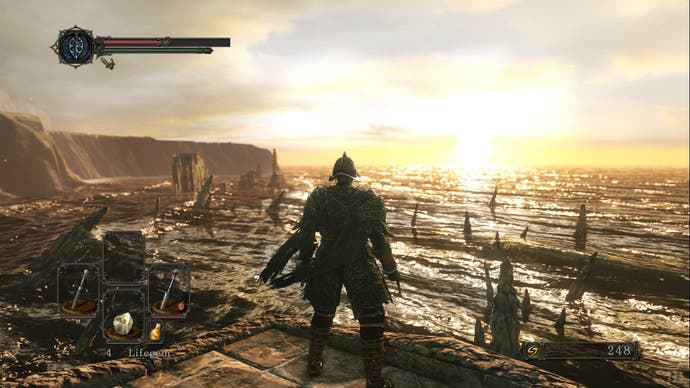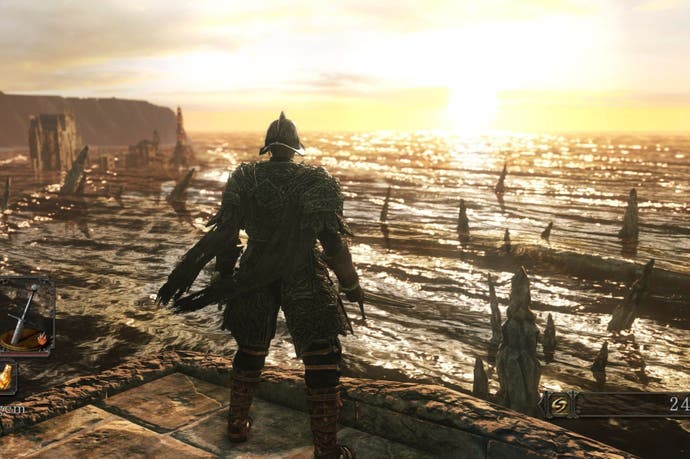Finding the humanity in Dark Souls 2
Jeffrey revisits Drangleic in From Software's divisive sequel.
Dark Souls 2 is a strange game, though its weirdness emanates from just how conventional it is - especially given it's part of a series known for forging new boundaries. Over a year ago I wrote about revisiting Demon's Souls and being delighted to find it the freshest, riskiest and most experimental title in From's recent action-RPG line-up. Dark Souls, despite technically being set in a different universe, superficially does the whole sequel thing - it adds more levels, more monsters, more spells, and more varied environments to an already winning template, but joined the dots in one glorious interconnected world.
It's hard to pinpoint what Dark Souls 2 added. The first "Souls" game not helmed by series director Hidetaka Miyazaki, Dark Souls 2 is a disappointingly conservative game. A majority of its environments feel like rehashes of prior "Souls" settings, so it's the third time we've seen From Software concoct a castle, a prison, and a dimly lit mire in this loosely defined series. This recycling of ideas is even truer of its bosses, which largely feel like remixes or modest adaptations of fiends we've fought before. More knights, more dragons, more cursed kings, etc. The rule of diminishing returns is in full effect.
Dark Souls 2 tries a little too hard to be accessible to newcomers. Where Demon's Souls and Dark Souls were content to make you struggle to figure out how to even cast a spell, Dark Souls 2 makes sure you learn the basics in its opening hours. It also lets you wear more stat-enhancing rings (you can equip four at a time rather than two), you can wear a higher percentage of gear without it slowing your roll, and bosses are noticeably easier. This greater transparency is certainly more welcoming, but it loses that same sense of wonder and intimidation Miyazaki's titles had in spades.

Worse, Dark Souls 2 is simply an uglier game than either of its predecessors. Even in its remastered edition this awkward sequel's generally garish lighting doesn't do any favours to its banal textures. Of course it's not going to look as good as From Software's PS4-exclusive follow-up, Bloodborne, but even the lower budget Demon's Souls holds up better today by masking its more mediocre assets in the shadows.
As such, Dark Souls 2 feels like a tribute to Miyazaki rather than one of his own works. But buried underneath its lacklustre imitation of the series' predecessors lies some truly inspired ideas. Ideas that were for some reason not repeated in the otherwise wonderful Bloodborne.
For one, it introduced the ability to replay boss fights at a harder difficulty without starting a whole new playthrough. This is important in a game known for its amazing boss fights and daunting length. Felling a particularly nasty foe is incredibly rewarding, but there's always a slight sense of melancholy when it's over as you know it will be several dozen hours until you can tackle the same beast again in another playthrough. Dark Souls 2 created a new item called a Bonfire Ascetic that resurrects the local boss and makes them even more difficult (and worth more souls to conquer). It's a subtle change, but a smart one.
More importantly, Dark Souls 2 is the only "Souls" title (including Bloodborne) that allows the player to continue exploring the world after defeating the final boss. As much as I appreciate From's gall to hide some of its best boss fights and environments in obscure secret areas, it was always dispiriting to realise after rolling credits that you missed something this vital. Given that Dark Souls 2 is easily the longest Souls game, its a godsend to be able to freely explore Drangleic in the post-game. Of all Dark Souls 2's most innovative additions, this is the only one to make the leap to its impending successor.

Furthermore, if and when you do decide to opt into New Game Plus - something you trigger at your own discretion when you're ready - it's populated by significantly tougher enemies, adding a further element of surprise as you fall back on old strategies only to realise how ill-equipped you are to take on this remixed adventure. I'm assuming Bloodborne eschewed this feature to remain consistent to that game's lore, but it's absence was certainly missed.
Dark Souls 2 also offers a Hard Mode, though it's not called that. Integrated into the game is the Covenant of Champions, a group you can join after the opening 20 minutes that makes the game significantly more difficult. Enemies hit harder, take less damage and you can't summon help (NPC or otherwise). It's clearly marked as a more sadistic route when you kneel before Victor's Stone to examine said covenant, thus offering the player an option for a more devious challenge.
If you don't enter this Covenant, you'll experience one of Dark Souls 2's most controversial changes: enemies stop respawning after being defeated roughly a dozen times. Some have pointed out that this isn't entirely consistent with the series' lore, but I'll be the first to admit that it's an inspired design choice. It both improves the pacing when you're retreading your way back to the same boss for the umpteenth time, and it makes the game more difficult as you can no longer rely on grinding the same high exp enemies to gain a few levels. In a sequel that's otherwise too eager to ween in newcomers, this design decision adds a small layer of permanence and consequence to a world that may otherwise feel to mollycoddling compared to it's Miyazaki-led brethren.

From also had the bright idea to design dark areas that would require wielding a torch - in lieu of a shield - to illuminate. This didn't go over so well in the game's original console release as its dim areas were still too easy to see in, but its Scholar of the First Sin remaster offers a greater glimpse as what From was going for. While criminally underutilised, the few places where a torch is damn near essential are tense, nail-biting experiences. This idea carried over briefly in Bloodborne, yet despite that game's grimmer tone and shadowy palette, its reliance on the torch was even more sparse.
Revisiting Dark Souls 2 now it's clear that the vague milieu of disappointment wasn't based on our desensitisation to From's fantasy saga, but rather the product of a rushed team making their biggest project yet with their master off working on something else (i.e. Bloodborne and now Dark Souls 3). While this so-called "B-Team" was either unwilling or unable to alter the course of Miyazaki's cult classic series, it did toy with lots of minor changes - and many of them paid off.
Miyazaki returning to direct Dark Souls 3 is certainly exciting, and while his underlings didn't quite hit the same highs as the master's work, they did an admirable job of holding down the fort in his absence. Dark Souls 3 is a return to form in many ways, as Rich Stanton and I have found, but there were still clever concepts Dark Souls 2 brought to the table that not even its delectable sequel would repeat. Dark Souls 2 was undoubtedly a hollower experience than its predecessor, but you needn't look too far to find its humanity.









